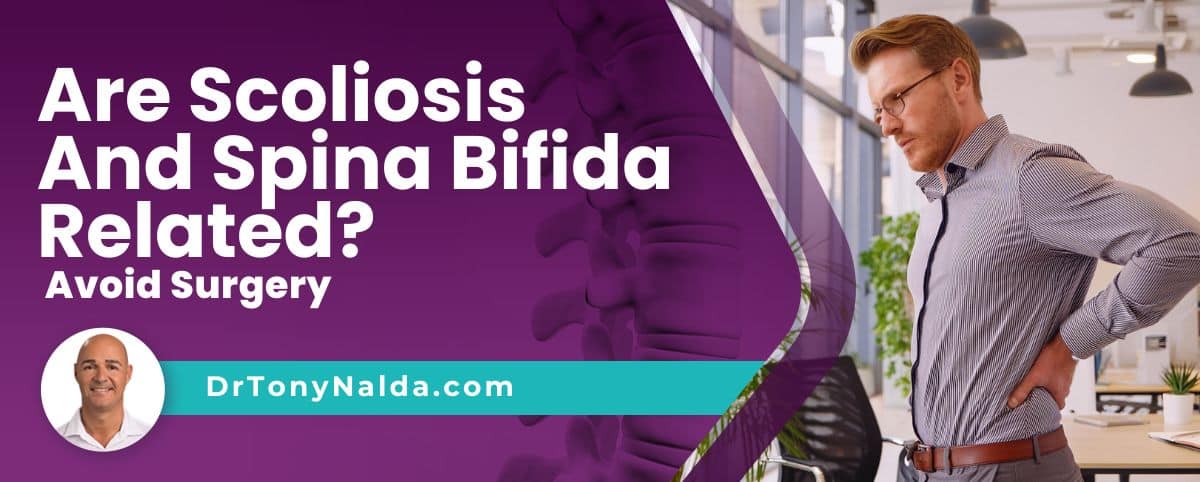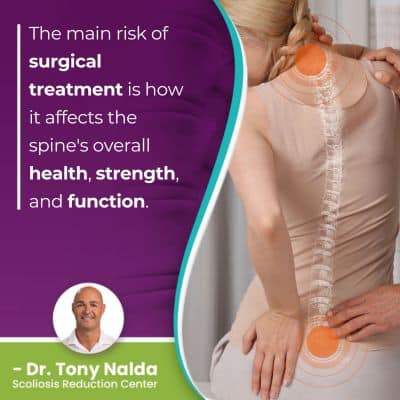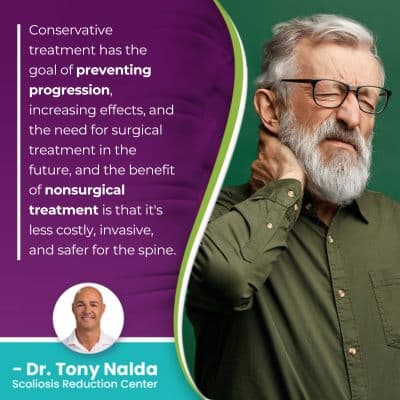Explore Scoliosis Alternative Treatment: Avoid Surgery

Particularly with early detection and intervention, there are fewer limits to what can be achieved with nonsurgical treatment. Conservative scoliosis treatment provides a safe alternative to invasive spinal surgery and has proven results.
Scoliosis surgery can make the spine weaker, more vulnerable to injury, and less flexible, while nonsurgical treatment options are less invasive and work towards preserving as much of the spine's natural strength and function as possible.
As how a diagnosis of scoliosis is responded to initially is so important, let's start with how different treatment approaches respond.
Table of Contents
Diagnosis and Treatment Response
When scoliosis is diagnosed, an unnatural spinal curve has developed, and as the condition's signs aren't always overt and can become more noticeable over time, a diagnosis doesn't mean the condition has just developed; it could have developed long before and been progressing since its initial onset.
In fact, in the most common type of adult scoliosis, these are cases of adolescents with adolescent idiopathic scoliosis who were neither diagnosed nor treated during their adolescence, and as their conditions progressed through time and maturity, they became more severe, noticeable, and painful in adulthood.
As a progressive condition, the nature of scoliosis is to get worse over time; the sideways bending and twisting spinal curve is getting larger, the condition's uneven forces are increasing, as are their effects.
So where a scoliosis is at the time of diagnosis doesn't mean that's where it will stay; proactive treatment is needed to counteract the condition's progressive nature.
With progressive conditions, sometimes when treatment is started can be as important as the type of treatment.
The sooner treatment is started, the better, but why is that?
The Benefits of Early Diagnosis and Intervention
When scoliosis is diagnosed early in its progressive line, there are treatment benefits available, but only to those who respond with a proactive treatment plan.
 Traditional scoliosis treatment is surgical and involves spinal fusion surgery.
Traditional scoliosis treatment is surgical and involves spinal fusion surgery.
Traditional treatment doesn't have a strategy for addressing scoliosis while mild so commonly recommends simply watching and waiting for signs of continued progression; to me, this is wasting valuable treatment time because meanwhile conditions are getting worse and becoming more complex to treat.
There are never treatment guarantees, but with early detection and treatment, there are fewer limits to what can be achieved with nonsurgical treatment.
As scoliosis progresses, the spine gets increasingly rigid, making it less responsive to treatment and making it harder for patients to perform therapeutic exercises as part of treatment.
Scoliosis exercises and physical therapy are important facets of an integrative conservative nonsurgical treatment approach.
The Risks of Surgical Treatment for Scoliosis
A traditional treatment response of observing, traditional bracing, and recommending surgical treatment when/if patients become severe does little to prevent progression, and instead responds with spinal fusion.
The main risk of surgical treatment is how it affects the spine's overall health, strength, and function.
While there are different types of spinal fusion (vertebral body tethering), surgical treatment is invasive; involves removing intervertebral discs sitting between adjacent vertebrae to be fused, and these are the curve's most-tilted vertebrae at the curve's apex.
The vertebrae are fused together as one solid bone, and this is to prevent the vertebral bodies from becoming more unnaturally tilted over time (progression), and metal rods are commonly attached to the spine to hold it in place, and hardware attached is permanent.
Risks associated with the procedure itself can include nerve damage, excessive blood loss, infection, and/or adverse reactions to hardware used.
What most concerns me, however, is how it shapes the spine's long-term health.
Spinal fusion is known to cost the spine in terms of its flexibility and range of motion, strength, and the fusion site can be painful.
And the reality is that many cases of scoliosis don't need surgery.
The Benefits of Nonsurgical Scoliosis Treatment
Nonsurgical scoliosis treatment doesn't permanently disrupt the spine's function as spinal fusion does; it can, however, improve it.
Conservative treatment has the goal of preventing progression, increasing effects, and the need for surgical treatment in the future, and the benefit of nonsurgical treatment is that it's less costly, invasive, and safer for the spine.
Nonsurgical treatment is proactive so is started as close to the time of diagnosis as possible because a mild scoliosis curve is simpler to treat than a severe scoliosis curve that's been left untreated.
Conservative treatment involves combining the benefits of multiple different treatments so conditions can be impacted on every level, and here at the Scoliosis Reduction Center, this involves condition-specific chiropractic care, physical therapy, corrective bracing, and rehabilitation.
 Treatment at the Center is intensive so is delivered in shorter high-intensity doses as significant curvature reductions are worked towards, and as progression is triggered by growth, particularly when treating childhood scoliosis, this is beneficial.
Treatment at the Center is intensive so is delivered in shorter high-intensity doses as significant curvature reductions are worked towards, and as progression is triggered by growth, particularly when treating childhood scoliosis, this is beneficial.
Treatment has to counteract the condition's progressive nature, despite the constant trigger of growth and development.
My phases of treatment focus on increasing the spine's mobility (progression makes the spine rigid), adjusting the position of the most-tilted vertebrae of the curve, and increasing the spine's stability for sustainable long-term treatment results.
Mobility Phase of Nonsurgical Treatment
Here at the Center, my state-of-the-art equipment and the power of mobility therapy exercises are the initial phase of treatment, and the goal is assessing the spine for areas of restricted movement and/or hypermobility.
Equipment and exercises are used to extend the spine and improve areas of rigidity, and as progression makes the spine increasingly rigid, this is a key benefit to starting treatment early, before significant progression has already occurred.
Establishing a baseline level of spinal flexibility is key for the next phase of treatment: the adjustments phase.
Adjustments Phase of Nonsurgical Treatment
As a structural spinal condition, scoliosis has to primarily be impacted on a structural level, and this is worked towards through a curvature reduction.
Curvature reductions involve a series of chiropractic techniques and manual adjustments that have the goal of repositioning the curve's most-tilted vertebrae back into alignment with the rest of the spine, restoring as much of the spine's healthy curves as possible, and impacting the condition's underlying structural nature.
My treatment approach and phases are foundational: each depends on the foundation established by the prior phase.
Increasing the spine's mobility makes it ready and responsive to chiropractic treatment, and the final stage of treatment is about holding the results.
Stability Phase of Nonsurgical Treatment
The final phase of treatment can be ongoing and involves further healing and stabilizing the spine through a variety of exercises (active and reactive, isometric, self-corrective, and body molding).
Corrective bracing can also help with providing additional stability and corrective results by pushing the spine into a straighter alignment.
Increasing core strength is also important as this means the spine's surrounding muscles are strong and can optimally support and stabilize it.
It's important to understand, however, that no type of exercise or exercise regime should be introduced unless it's first approved by a patient's scoliosis treatment provider.
When each phase of treatment is strong and effective, the end result can be a spine that's stronger, more flexible, has its healthy curves restored, is responsive to treatment, and one that's supported and stabilized by strong surrounding muscles.
Conclusion
When it comes to treating scoliosis, the key is to be proactive and understand the different treatments available, and the risks and benefits associated with each.
When it comes to traditional surgical treatment, this is risky and invasive, and while it can straighten a bent spine, the way it does so is contrary to the spine's movement-based design so comes at a cost.
Nonsurgical conservative treatment has a number of benefits including; it's less costly, invasive, risky, and prioritizes the spine's natural strength and function.
When scoliosis is impacted on every level, treatment results can mean a better quality of life and a healthier spine.
For patients choosing to forgo a surgical recommendation, or who want to try a safer less invasive alternative treatment option first, conservative nonsurgical treatment has impressive results that are achieved by customizing treatment plans around patient age, condition type, severity, and curvature location.
The main type of scoliosis is idiopathic scoliosis, and the most prevalent type overall is adolescent idiopathic scoliosis, but there is also congenital scoliosis, infantile, early onset scoliosis, and adult scoliosis; all types require treatment, but not all require surgery.
The best way to address early onset scoliosis is proactively as this can prevent scoliosis from getting worse and needing a more invasive form of treatment; mild curves are smaller and simpler to treat, and the best way to correct scoliosis is through combining different treatment disciplines for the best results.
Dr. Tony Nalda
DOCTOR OF CHIROPRACTIC
After receiving an undergraduate degree in psychology and his Doctorate of Chiropractic from Life University, Dr. Nalda settled in Celebration, Florida and proceeded to build one of Central Florida’s most successful chiropractic clinics.
His experience with patients suffering from scoliosis, and the confusion and frustration they faced, led him to seek a specialty in scoliosis care. In 2006 he completed his Intensive Care Certification from CLEAR Institute, a leading scoliosis educational and certification center.
About Dr. Tony Nalda
 Ready to explore scoliosis treatment? Contact Us Now
Ready to explore scoliosis treatment? Contact Us Now





